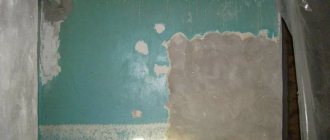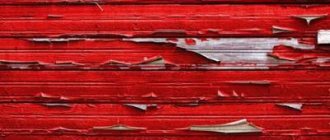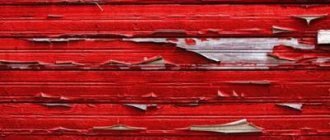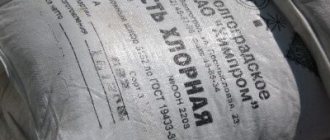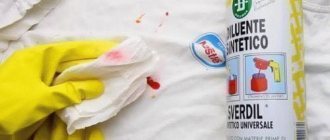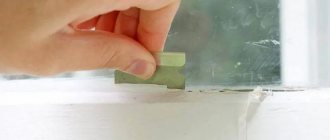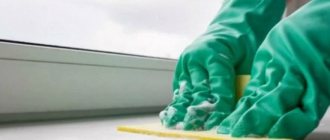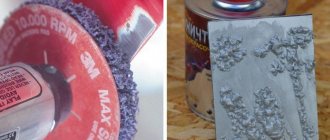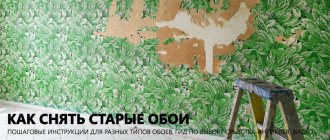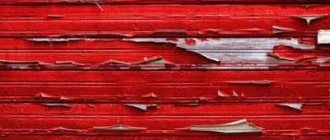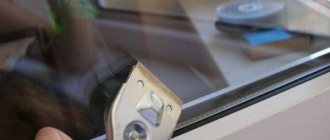Repainting walls is sometimes very difficult if there is old enamel on them. Often owners want to decorate the interior differently or simply update the design. If you have already purchased tools and selected good paint for exterior work, you can safely begin the repair. You just need to remove the base coat that has become unusable.
There are several ways you can remove old water-based paint. They are all quite simple, you just need to follow simple rules. Let's talk in more detail about such methods and note their features. After reviewing our material, you can choose the most convenient and practical option for yourself.
Use of solvent and its derivatives
Like all paints, water-based paint can be easily removed with a solvent. Such compositions are often used to treat walls before painting. Even if the old film is quite thick, it can be quickly removed with the following substances:
- isopropyl alcohol;
- solvent;
- formic alcohol;
- white spirit.
Such compounds are quite toxic, so it is advisable to work with them in personal protective equipment. Use respirators and special glasses to protect your eyes and respiratory organs.
Rinse with water
To carry out this work you need the following tool:
- stepladder or stable chair;
- putty knife;
- paint roller on a long handle;
- basin;
- metal brush;
- film or old newspapers;
- safety glasses and respirator.
Video: How to remove water-based paint from a ceiling
Water-based paint may not be waterproof or waterproof. Waterproof emulsion is a little more difficult to wash off. If the ceiling or walls are painted with a non-waterproof emulsion, the following method is suitable for removing it:
- Cover the furniture and floor with film or newspapers.
- Wear safety glasses and a respirator.
- Prepare a container with warm water.
- A roller soaked in water is passed over the surface that needs to be cleaned of old paint.
- Leave the wetted surface to soak for 10 - 15 minutes.
- Using a spatula, scrape off the soaked water emulsion.
- Places that are not completely cleaned should be moistened again or cleaned with a wire brush.
You should not wet the entire ceiling or wall at once, since by the time it gets to the distant areas, they will dry out. It is better to work with small areas, gradually moving over the entire surface.
How to remove waterproof emulsion paint
It is often used in rooms with high humidity (bathrooms, kitchens). If you don’t know what kind of paint the surface is covered with, just moisten it with water and leave it for a few minutes; if the water-based emulsion does not peel off, it means it is waterproof and vice versa.
Waterproof emulsion can be cleaned off with a wire brush. When brushing over the surface, try to leave a lot of scratches. After this, it is wetted, the water entering the resulting scratches penetrates deeply into the paint layer and softens it.
The wetting procedure is repeated several times until it is saturated and swollen. After this, the paint is scraped off with a spatula.
Water-based paint can be removed using paste or wallpaper glue. Glue is applied to it and newspapers are glued. The paper should stick well. When the glue dries, it is removed with a spatula, and the water-based emulsion is also removed along with the paper.
If you have a tool such as a drill or hair dryer, you can use one of the following two methods for removal - thermal or mechanical.
Paint removers
They sell ready-made paint remover solutions in spray cans - they are quite effective and easy to use. They are applied to a dry, clean surface and removed after a few minutes. They quickly dissolve the old coating; it can be easily removed with a rag. Detailed instructions are indicated on the packaging. These compositions are very dangerous for mucous membranes; you must also work with them using personal protective equipment. In case of contact with the eyes, nose or mouth, the substance should be washed off the surface with a large volume of clean running water.
Do I need to wash it off?
If the water-based emulsion holds tightly and there are no areas with paint peeling, you can leave it. A new layer is applied to the old paint. If there are bubbles or areas of peeling paint on the surface, then the old layer of water-based emulsion must be removed.
Removal will be required during major repairs or if the surface is finished with another material incompatible with water-based paint. Removal is also required if the color changes from dark to lighter. The dark color will show through the light color, regardless of the number of layers applied.
You can delete it in several ways:
- wash off;
- remove thermally (annealing);
- mechanical method.
Soap solution
To effectively remove water-based emulsion stains on a hard surface, you can use a soap solution. To prepare it:
- Take a basin and fill it with 3 liters of warm water.
- Place a bar of solid soap there and wait for it to completely dissolve.
- stir until a smooth white consistency is obtained.
- soak a sponge in the product and wipe the contaminated surface with it.
In case you were unable to remove the paint stain the first time, try making the solution more concentrated: place two bars of soap in the same amount of water. The composition can be left on the stain for 15-20 minutes for deep removal.
Soap solution for cleaning water-based emulsion stains Source posudaguide.ru
Is it worth removing the old coating?
If there are no areas of peeling or swelling on the surface in question, then the water-based paint does not need to be removed. Removal is necessary in the following cases:
- the presence of exfoliated areas;
- air getting under the paint;
- applying a lighter coating (no matter how many layers there are, the dark tone will show through and the desired shade will not be achieved);
- if the finishing material used is not compatible with water-based paint.
For removal you will need the following materials:
- film (polyethylene) and waste paper;
- container with water;
- rags;
- metal spatulas;
- soft roller for wetting walls;
- brush with metal teeth;
- sandpaper;
- acetone;
- construction solvent;
- protective clothing: goggles, respirator, gloves, head covering;
- a small ladder or stepladder.
Water-based paint can be removed by washing it off with water, cleaning the walls mechanically, using solvents, or using heat treatment.
It is recommended to wash off water-based paint with a soap solution, which is prepared by dissolving soap or a little washing powder in warm water. It is then applied to the wall with a roller or sponge and left to absorb for a while. When the paint layer is sufficiently wet, it is washed off with a rag, after which the wall is wiped dry. If, after completing the work, there are still traces of soap on the wall, you need to repeat the procedure again.
It is recommended to soften dried stains with warm water if their size is large. Leave the wet cloth on for about half an hour and then wash off the stain.
General recommendations
There are several recommendations that will help you cope with the cleaning process faster:
- When trying to get rid of a stain, only wet a small area. Otherwise, the surface dries out quickly, and the procedure has to be repeated again;
- paint sometimes gets on furniture. Don't wait until it dries and gets absorbed. Wet pigment paint is much easier to remove without the use of physical effort;
- It’s easiest to immediately blot water emulsion that has dropped onto clothing with a napkin, but if possible, you can immediately rinse the contaminated area with running water.
Professional tool
This could be a sanding machine for construction work. You can replace this tool with a drill or screwdriver. A special attachment for grinding is put on the head of the device, which, when started, begins to actively rotate and remove paint mechanically. For this procedure, the surfaces are not wetted.
A sander will remove water-based emulsion paint professionally Source ftool.ru
When to shoot
There are cases in which the old coating can be left on the treated surface and situations in which the removal of the existing layer of water-based emulsion is a categorical requirement that affects the quality of subsequent work. Recent cases include:
Among the methods used to remove finishing material, characterized by a good degree of adhesion in relation to the surfaces on which it is applied, there are: mechanical, chemical and thermal removal of the old coating.
New technologies
The chemical industry is developing rapidly, offering builders new approaches to solving problems.
The question of how to remove water-based paint from a wall quickly, without wasting extra money, effort and time, has also been resolved.
For this, not just water is used, but a special wash.
The special liquid contains substances that break down all insoluble components of the emulsion.
Thanks to the chemical rinsing method, you get:
- rapid softening of the water-based paint layer on the wall;
- easy rinsing of paint residues with water;
- clean, undamaged wall surface;
- cleaning large areas in a short time;
- minimum amount of labor to carry out large volumes of work.
Include a small cost for a special product in your repair estimate to speed up the process and improve the final result of washing off water-based paint from the wall.
Mechanical method
The paint can be removed with a brush or using a sanding machine.
First method
Before cleaning, the walls are moistened with water using a roller and left to soak for 15 minutes. Then use a spatula to scrape off the paint layer, working in one direction. Places where the coating cannot be removed are treated with a brush with metal teeth.
This method is only suitable for surfaces that are resistant to mechanical damage.
Second method
The layer can be removed very effectively with a sander. If you don’t have one, you can use a drill with a paint removal attachment. It comes in the form of a metal crown or a round brush with iron bristles. They can be purchased at a specialty store or at the market.
The use of a grinding machine is recommended for cleaning walls made of wood, less often concrete.
Sequencing:
- Connect the instrument to the network.
- Clean the walls. You need to move sequentially, working in small areas.
- The surface should be wiped with a wet cloth to remove dust.
- At the end of the work, the room must be vacuumed and all traces of paint removed.
- Perform wet cleaning and ventilate the room.
Be sure to wear a respirator and safety glasses, because the air will be very dusty.
Features of water-based paint
Work on removing water-based emulsion at home is always accompanied by the appearance of dust and dirt. Often the process turns out to be quite complicated because the characteristics of a particular solution were not taken into account. Therefore, it is necessary to evaluate in advance the features of the composition applied to the walls.
Water-based solutions are usually divided into two categories:
- Water resistant. This variety includes a large group of materials that, after drying, become resistant to moisture. They are used for painting rooms with high levels of humidity and for working with walls outdoors.
- Non-waterproof. Such compositions are not resistant to humid environments, so they are used exclusively for indoor use.
These features should be taken into account in order to remove the old layer without significant costs.
What is not recommended to do
There are several points that you should not do when working with cleaning a surface from old paint. Do not use metal bristles on soft surfaces that may be damaged by its impact.
Don't expect that applying different colors of water-based paint on top of each other will produce a nice color. More often than not, the result is unattractive, and this leads to repeated work.
It is not recommended to carry out work without protective equipment and in a poorly ventilated area. You should not use products that are not suitable for treating a specific type of surface.
Don't expect that applying different colors of water-based paint on top of each other will produce a nice color.
We recommend
DOCKER S4 is a universal, effective general-construction remover of all types of paintwork. Designed for outdoor use. Used for removing paint coatings, old polyurethane, epoxy, acrylic and other paints from metal, wood, and concrete surfaces. Particularly effective for powder paints.
Does not contain acid. More details
DOCKER S5 is an industrial remover of chemically resistant, complex paintwork with fast action (3-10 min.) Effectively removes multi-layer coatings, NC, CV paints, primers, enamels, putties, thermal paints. Can be used for interior and home work. Gel solution. Without smell. More details
How to remove old paint from walls How to remove water-based paint from a wall
How to use a special remover
- Choose the right product in the required quantity.
- Read the instructions carefully.
- Prepare working tools and protective clothing.
- Apply the product with water or a prepared solution to the wall.
- Wait 10 - 15 minutes for the solution to soak into the paint and begin to break it down.
- Check the degree of degradation of water-based paint on a small section of the wall.
- Remove layers with a spatula.
- Moisten the remaining areas of paint with the solution again and repeat the removal procedure.
